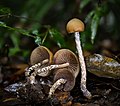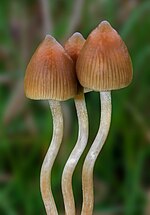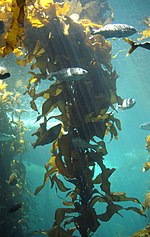In botany, a stipe is a stalk that supports some other structure. The precise meaning is different depending on which taxonomic group is being described...
2 KB (232 words) - 21:53, 19 August 2023
Plant stem (redirect from Internode (botany))
'Contorta') Red, peeling bark of paperbark maple Edible plant stem Stipe (botany) Plant Stems: Physiology and Functional Morphology. Elsevier. 1995-07-19...
17 KB (2,131 words) - 13:44, 23 August 2024
Rachis (redirect from Rachis (botany))
rachillae with attached leaflets Inflorescence of Buddleja paniculata Stipe (botany) Henry George Liddell, Robert Scott, A Greek–English Lexicon, ράχις...
3 KB (315 words) - 16:03, 29 November 2023
Stipe (botany), a stalk that supports some other structure Stipe (mycology), a stem or stalk-like feature supporting the cap of a mushroom Stipe (graptolite)...
391 bytes (88 words) - 18:48, 14 April 2024
Glossary of botanical terms (redirect from Olim (botany))
botanical terms is a list of definitions of terms and concepts relevant to botany and plants in general. Terms of plant morphology are included here as well...
344 KB (29,067 words) - 03:50, 1 October 2024
or seated directly on the surface of the substrate, lacking a supporting stipe or pedicel. Beentje, H.; Williamson, J. (2010). The Kew Plant Glossary:...
2 KB (181 words) - 00:06, 15 July 2024
to funnel-shaped caps measuring 7–30 cm (3–12 in) wide set atop a thick stipe up to 8 cm (3 in) long. The gills on the cap underside are closely spaced...
21 KB (2,153 words) - 05:49, 11 July 2024
Frond (redirect from Frond (botany))
the main stem. In botany, this leaf stalk is generally called a petiole, but in regard to fronds specifically it is called a stipe, and it supports a...
11 KB (1,354 words) - 16:16, 18 September 2024
out, while around the stipe they dent in strongly. The pore covering is easy to remove from the skin of the pileus. The stipe is 5–15 cm (2–6 in) long...
7 KB (691 words) - 04:45, 10 January 2024
species have rounded, forked folds that run almost all the way down the stipe, which tapers down from the cap. Many species emit a fruity aroma and often...
17 KB (1,891 words) - 11:19, 27 August 2024
attachment to the stipe. There are short gills (lamellulae) interspersed between some, but not all, of the long gills. The smooth stipe measures 3–4 cm...
4 KB (404 words) - 19:21, 21 September 2024
presence of either a ring on the stipe, a partial veil adhering to the cap margin, or a "false veil" not attached to the stipe but initially covering the tube...
48 KB (4,994 words) - 01:28, 18 August 2024
clade of morels is the presence of a sinus where the cap attaches to the stipe. Leaf shape Sulcus (morphology) Hickey, M.; King, C. (2001). The Cambridge...
1 KB (128 words) - 00:48, 20 August 2023
radial or linear grooves that extend nearly to the center, rest atop whitish stipes up to 10 cm (4 in) long. In young specimens, the entire cap surface is coated...
42 KB (4,554 words) - 10:03, 6 August 2024
Leaf (redirect from Leaves (botany))
these structural components. The proximal stalk or petiole is called a stipe in ferns. The lamina is the expanded, flat component of the leaf which contains...
113 KB (11,733 words) - 08:05, 4 September 2024
(sometimes decurring) is a term used in botany and mycology to describe plant or fungal parts that extend downward. In botany, the term is most often applied...
2 KB (241 words) - 07:46, 21 May 2023
Psilocybe zapotecorum (section Stipe)
of the stipe. The partial veil is white and arachnoid, disappearing in age. Often a long pseudorrhiza can be found attached the base of the stipe. Strongly...
10 KB (781 words) - 00:23, 19 May 2024
mature. Their stipes tend to be slender and long, and the same color or slightly lighter than the cap. The gill attachment to the stipe is adnexed (narrowly...
55 KB (5,896 words) - 20:34, 5 August 2024
three regions. The parts of a kelp thallus include the holdfast (anchor), stipe (supports the blades) and the blades (for photosynthesis). The thallus of...
3 KB (311 words) - 22:41, 11 March 2024
attached by its discoid holdfast and a short inconspicuous stipe epiphytically on to the stipe of Laminaria or to rocks. The fronds are variable in shape...
14 KB (1,512 words) - 00:09, 11 August 2024
stipe that has neither a partial veil nor prominent, colored glandular dots. The cap can reach a diameter of about 10 cm (3+7⁄8 in), while the stipe is...
27 KB (2,861 words) - 01:27, 18 August 2024
informally recognized: Cortinate supersection: The stipe is only pruinose at the apex or the upper half. The stipe base is (generally) not bulbous and a remnant...
16 KB (1,612 words) - 01:28, 29 May 2024
slightly discolored, homogeneous, with white lines of mycelium near the stipe, 2-3.5 cm. thick; tubes annual, 1 cm. long, avellaneous within, mouths circular...
6 KB (580 words) - 09:19, 21 February 2024
from bright orange to salmon orange on the upper surface of the cap and stipe, with a yellow pore surface on the cap underside. Spores are egg-shaped...
4 KB (386 words) - 14:26, 19 January 2024
hardwood substrates and occasionally having a reduced, eccentric or "wanting" stipe. In 1908, Atkinson considered G. tsugae and G. sessile as synonyms of G...
14 KB (1,306 words) - 00:47, 31 August 2024
species, he described the genus as those mushrooms with a centrally placed stipe, a distinct ring, a circular cap, and tubes that are stuck together. They...
19 KB (1,572 words) - 06:34, 15 August 2024
colored when the spores mature. Lamellae come close to the stipe, but do not touch it. Stipe: White and thin. It was noted in Asia and Europe, North America...
2 KB (185 words) - 23:17, 18 April 2024
cap underside are closely spaced and free from attachment to the slender stipe, which has a loose ring on its upper half, and a bulbous base. The edibility...
15 KB (1,562 words) - 01:53, 16 May 2024
Sporophytes are perennial and the individual may live for up to three years; stipes/fronds within a whole individual undergo senescence, where each frond may...
34 KB (4,032 words) - 22:17, 15 September 2024
one holdfast, although some species have more than one stipe growing from their holdfast. A stipe is a stalk or stemlike structure present in an alga. It...
59 KB (5,896 words) - 08:15, 26 August 2024




























